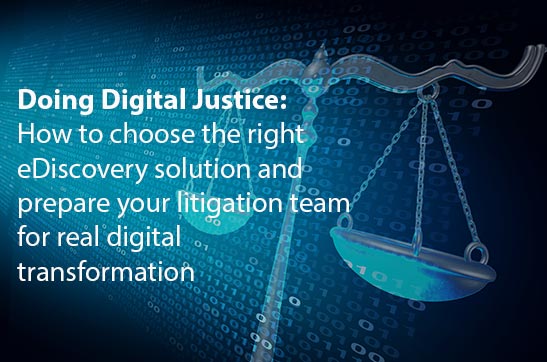The legal sector has ignored digital best practices for too long. Now, most litigation teams need to adapt if they want to survive. Find out how to choose the right eDiscoverysolution and take the first step towards transforming your team for good.
What does ‘digital transformation’ really mean? And why does it matter?
Of all the leading buzz phrases that have rumbled through the meeting rooms and press releases of every professional sector, ‘digital transformation’ is one that has rung the loudest, and it is certainly showing no signs of fading out any time soon.
While the term is self-explanatory to a degree, for the complete avoidance of doubt, Salesforce kindly defined digital transformation as ‘the process of using digital technologies to create new — or modify existing — business processes, culture, and customer experiences to meet changing business and market requirements’ going on to clarify that it is the ‘reimagining of business in the digital age.’
For any legal team, sound eDiscovery forms the bedrock of desirable digital transformation.
The legal state of play
Those of you reading this are likely all-too familiar with the rigid nature and pace of the legal profession, it will therefore come as no surprise that the industry as a whole has been shown to be lagging from a technological standpoint. This is not only in comparison to other sectors, but the general digital competencies of the public at large. According to Gartner, only 19% of in-house legal teams are well positioned to support enterprise digital efforts.
For those working on litigation support teams, this means that pressure is mounting in several directions – managers are not only finding themselves expected to know the ins and outs of complex eDiscovery tools and services, but are also being pressed to invest in one that delivers demonstrable results, fast. And as if that wasn’t enough, as other sectors have evolved and adapted to the new era of data-driven practices, the margin for error has been dramatically reduced.
So, there’s no time to waste. It’s time to learn how you can suss out the right eDiscovery solution for you and your team.
Choosing the right solution: your eDiscovery checklist
eDiscovery was founded to change the labour intensive nature of managing, storing and classifying legal documents. Unfortunately though, poor decision-making with regards to the right eDiscovery solution, provider, and even adoption process for your team can actively undo the very efficiencies you are looking to achieve.
We’ll go into each point in detail, but if you want to select an eDiscovery solution that will deliver the results you need, these are the key criteria you need to be looking for:-
- The latest forensic data collection capabilities
- Proven and trustworthy security credentials
- Advanced integration and compatibility
- Flexible managed services options
- Round-the-clock technical support




